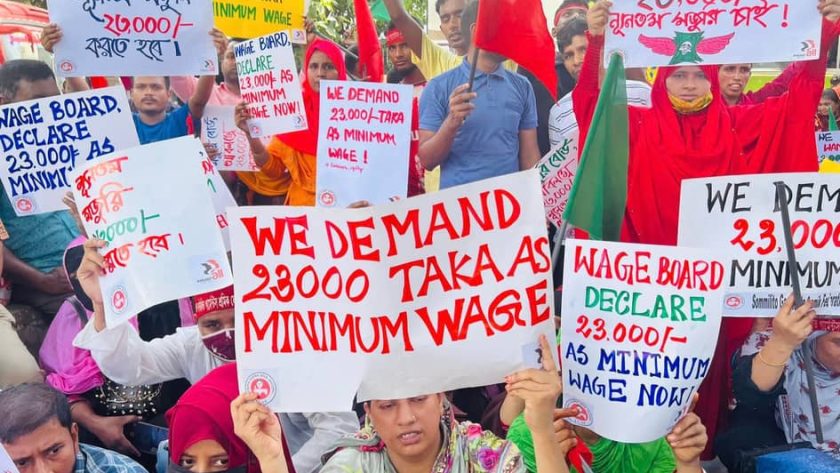Bangladesh has been in the news recently — minimum wage discussions have turned sour with enraged garment workers taking to the streets for the second week. Two workers have died and sentiments are flaring up on both sides. What is the issue?
While garment workers and their unions demand a minimum wage of 23,000 Bangladeshi taka (around 209 US dollars) – a figure unions agreed on unanimously in a historic first – the government’s wage board, comprised largely of garment factory owners, proposes a minimum wage of 10,400 taka (around 94 US dollars). The current minimum wage stands at 8,000 taka (almost 73 US dollars) and was last reviewed in 2018. Since then, Bangladesh’s annual inflation rate has been around 5.5 percent, with a spike in 2022 to 7.7 percent.
How was the proposed minimum wage calculated?
A recent press conference with garments workers and representatives of various labour organisations, organised by non-profit organisation Remake, shed light on how unions arrived at the figure.
Thirty-wo-year-old garment worker Jahanara Begum illustrated her earnings during her 18-year career as an operator in the swing sector for Ashiq Jeans Apparels Ltd., a member of the Bangladesh Garment Manufacturers and Exporters Association (BGMEA). When she joined, her wage was only 700 taka (6.35 US dollars) a month; over the years it has gradually increased to 11,700 taka (106 US dollars). She works 10 to 12 hours a day.
Her husband works 12 to 14 hours as a supervisor at a different garment factory and earns 18,000 taka a month, thus bringing the family income to 29,700 taka per month. The family consists of Jahanara and her husband, their children and their ageing parents. The list below shows how the income is spent:
- food: 19,000 taka
- children’s education: 7000 taka
- rent: 6,000 taka
- expenses for parents: 4,000 taka
- medicines: 1,000 taka
- Total: 37,000 taka
As the list shows, more than one full income is spent each month on food, followed by school fees for the children, rent, expenses for the parents and medicines that have to be taken regularly. Each month, the couple exceeds their budget by 7,300 taka without taking into account expenses for electricity, water and fuel. This money has to be borrowed from relatives or colleagues and re-borrowed to pay off these loans. It is a vicious cycle.
“Even after giving 18 years of my life to the garment industry, I could not save even 18,000 taka for the future,” is Begum’s sad conclusion. But that is not all – everyone’s health and especially hers is affected due to poor nutrition.
Food prices have risen
“Mainly due to the increase in food prices, it is not possible to ensure enough nutritious food for all members of the family. Due to lack of income, I am currently forced to reduce the amount of food I purchase. In order to meet the nutritional needs of the family, I am taking less food every day,” she adds.
The price for a kilogram of potatoes has risen from 30 taka to 70 taka in just one year; the price for a kilogram of onions even more dramatically from 50-60 taka to 130 taka.
When borrowing and further cutting essentials does not work anymore, the next step is to increase income by having those chip in who are currently in school: “If the salary is not increased, I will have to let my child engage in child labour instead of education to meet household expenses,” fears Begum.
Minimum wages in comparison
Bangladesh is the second largest RMG exporter after China, employing over 4.4 million workers, of which 70 percent are women. The country’s RMG sector accounts for over 80 percent of its total export earnings and contributes more than 11 percent to the national GDP.
In comparison, minimum wages in other garment-producing countries are higher, with Cambodia leading the way with 200 US dollars per month, followed by Vietnam with 192 US dollars, India with 165 US dollars, China with 161 US dollars and Pakistan with 110 US dollars.
The wage board decision was due today, 1st November 2023. FashionUnited will keep updating this article as further news come in.



